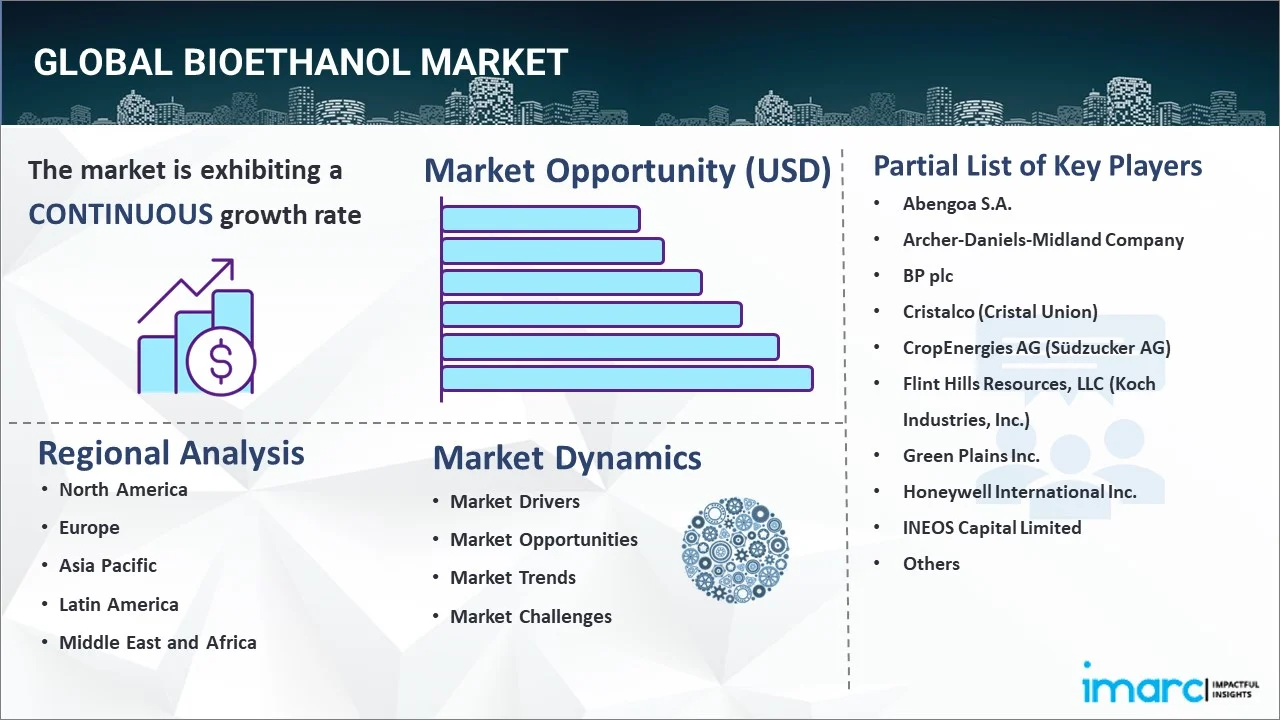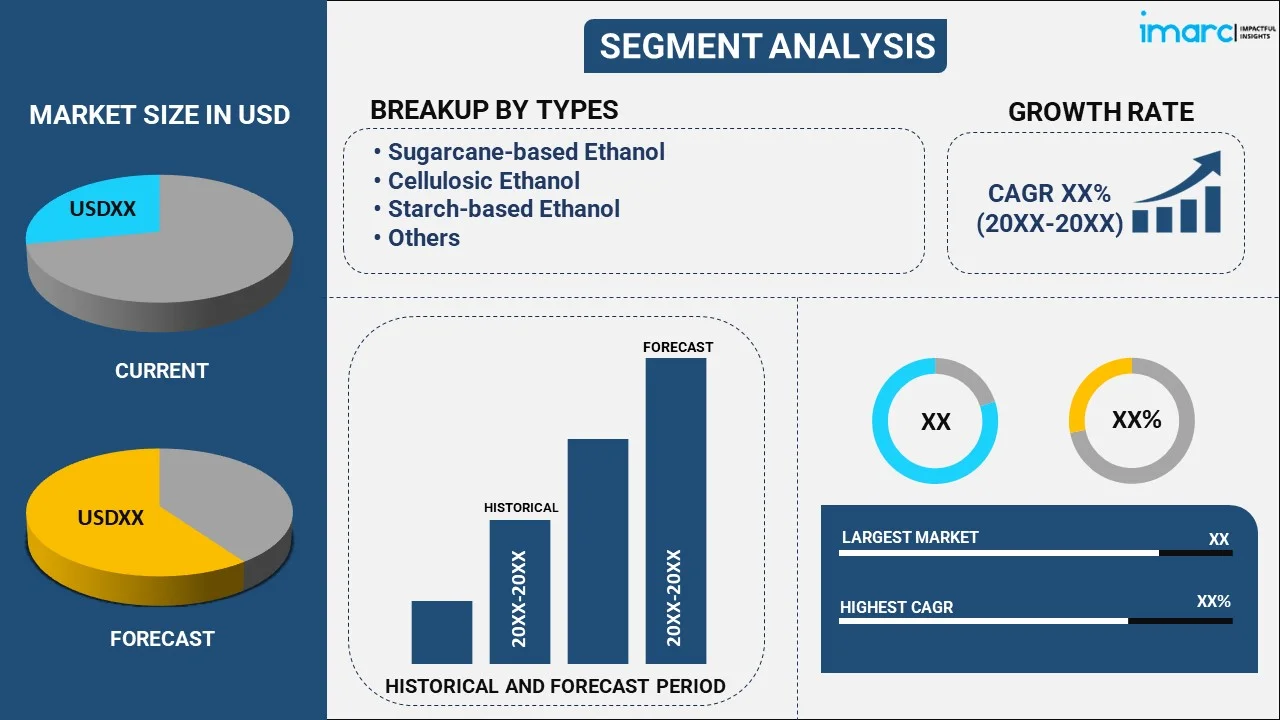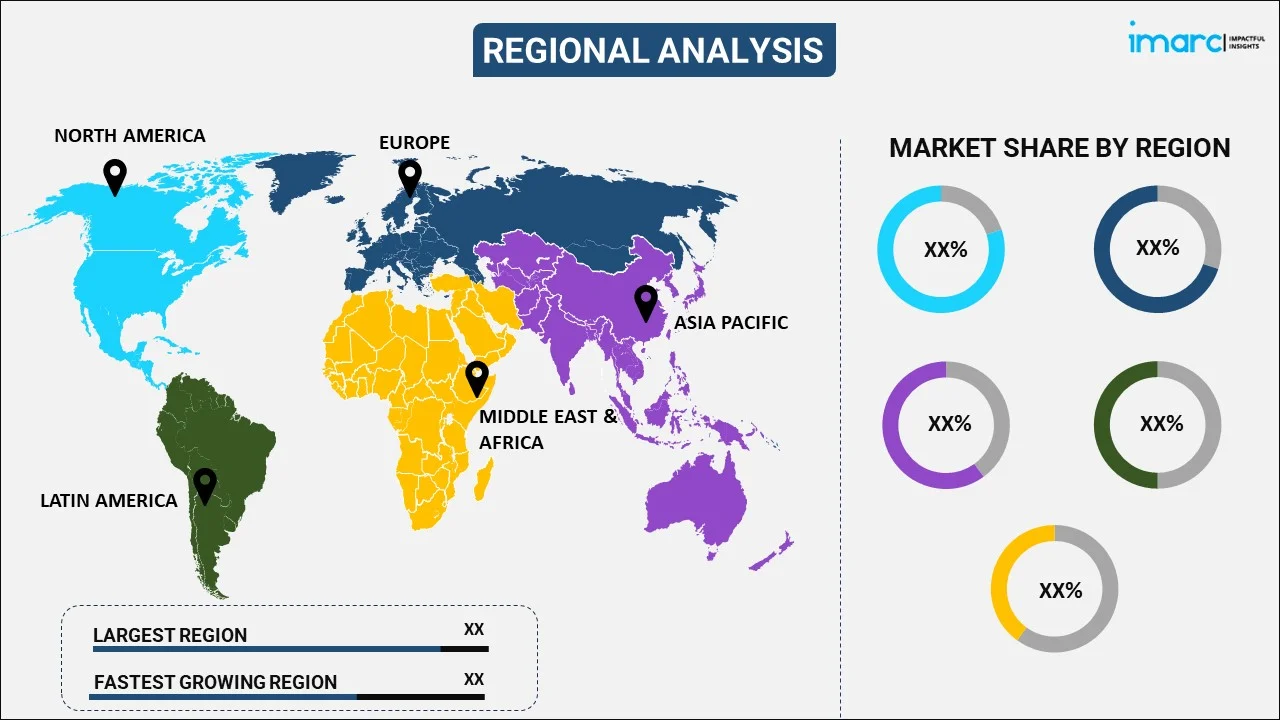
Bioethanol Market Report by Type (Sugarcane-based Ethanol, Cellulosic Ethanol, Starch-based Ethanol, and Others), Fuel Blend (E10, E20 and E25, E70 and E75, E85, and Others), Generation (First Generation, Second Generation, Third Generation), End Use Industry (Automotive and Transportation, Power Generation, Pharmaceutical, Food and Beverage, Cosmetics and Personal Care, and Others), and Region 2025-2033
Market Overview 2025-2033:
The global bioethanol market size reached USD 10.7 Billion in 2024. Looking forward, IMARC Group expects the market to reach USD 18.7 Billion by 2033, exhibiting a growth rate (CAGR) of 6.05% during 2025-2033. At present, North America holds the largest market share, driven by government mandates for renewable fuels, the increasing demand for low-emission energy sources, advancements in biofuel technology, and rising awareness about the environmental benefits of bioethanol as a sustainable alternative to fossil fuels.
|
Report Attribute
|
Key Statistics
|
|---|---|
|
Base Year
|
2024 |
|
Forecast Years
|
2025-2033
|
|
Historical Years
|
2019-2024
|
| Market Size in 2024 | USD 10.7 Billion |
| Market Forecast in 2033 | USD 18.7 Billion |
| Market Growth Rate (2025-2033) | 6.05% |
Bioethanol is a clear, colorless liquid produced from biomass by hydrolysis and sugar fermentation or using the chemical process of reacting ethylene with steam. It is biodegradable, less toxic, and does not cause environmental pollution as compared to conventional fuels. Consequently, it is gaining traction as a petrol substitute for road transport vehicles around the world. It is blended with petrol without modifying engine designs, which results in reduced greenhouse gas (GHG) emissions and air pollution. Presently, the ongoing research and development activities to produce bioethanol fuel using municipal solid waste are escalating the demand for bioethanol worldwide.

Bioethanol Market Trends:
Growing Government Policies and Renewable Fuel Standards
Government mandates, particularly in North America and Europe, have been critical in driving the bioethanol market growth. Policies like the U.S. Renewable Fuel Standard (RFS) and Canada’s Clean Fuel Standard set quotas for renewable fuel usage, creating stable demand for bioethanol as a sustainable alternative to gasoline. Tax incentives and subsidies further incentivize production and adoption, encouraging investments in bioethanol production facilities. According to the bioethanol market analysis, these regulatory frameworks aim to reduce greenhouse gas (GHG) emissions and fossil fuel dependency, pushing oil refineries to blend bioethanol with conventional fuels to meet environmental standards. Compliance with these mandates has become a key factor propelling market growth as nations pursue ambitious decarbonization goals.
Rising Environmental and Consumer Demand for Sustainable Fuels
The growing awareness of climate change and environmental impact has led to the increased consumer demand for cleaner, renewable energy sources. Bioethanol, derived from plant materials, has a significantly lower carbon footprint than fossil fuels, making it attractive for individuals and businesses aiming to reduce emissions. Bioethanol-fueled vehicles emit fewer pollutants, contributing to improved air quality and public health benefits. As more consumers and industries prioritize sustainability, bioethanol’s role as a renewable fuel becomes increasingly relevant. In addition to this, this demand fuels innovations in production efficiency, crop yield improvement, and bioethanol blends, solidifying its position in the renewable energy market.
Significant Advancements in Bioethanol Production Technologies
Technological progress in bioethanol production, including cellulosic bioethanol and enzyme engineering, is driving market expansion. Innovations enable more efficient use of feedstocks, including agricultural waste, and reduce production costs, making bioethanol more competitive with conventional fuels. Cellulosic bioethanol, derived from non-food sources like crop residues, reduces food competition, thus broadening bioethanol’s sustainability appeal. In addition to this, advancements in biotechnology, such as genetically engineered yeasts and improved fermentation processes, increase production yields and enhance process efficiency. These innovations make bioethanol an increasingly viable and scalable alternative to gasoline, encouraging investments and stimulating the bioethanol market growth.
Key Market Segmentation:
IMARC Group provides an analysis of the key trends in each sub-segment of the global bioethanol market report, along with forecasts at the global, regional and country level from 2025-2033. Our report has categorized the market based on type, fuel blend, generation and end use industry.
Breakup by Type:

- Sugarcane-based Ethanol
- Cellulosic Ethanol
- Starch-based Ethanol
- Others
Breakup by Fuel Blend:
- E10
- E20 and E25
- E70 and E75
- E85
- Others
Breakup by Generation:
- First Generation
- Second Generation
- Third Generation
Breakup by End Use Industry:
- Automotive and Transportation
- Power Generation
- Pharmaceutical
- Food and Beverage
- Cosmetics and Personal Care
- Others
Breakup by Region:

- North America
- United States
- Canada
- Asia-Pacific
- China
- Japan
- India
- South Korea
- Australia
- Indonesia
- Others
- Europe
- Germany
- France
- United Kingdom
- Italy
- Spain
- Russia
- Others
- Latin America
- Brazil
- Mexico
- Others
- Middle East and Africa
Competitive Landscape:
The report has also provided a comprehensive analysis of the competitive landscape in the global bioethanol market. Detailed profiles of all major companies have also been provided. Some of the companies covered include:
- Abengoa S.A.
- Archer-Daniels-Midland Company
- BP plc
- Cristalco (Cristal Union)
- CropEnergies AG (Südzucker AG)
- Flint Hills Resources, LLC (Koch Industries, Inc.)
- Green Plains Inc.
- Honeywell International Inc.
- INEOS Capital Limited
- Petróleo Brasileiro S.A.
- POET LLC
- Royal Dutch Shell plc
- Valero Energy Corporation
Kindly note that this only represents a partial list of companies, and the complete list has been provided in the report.
Bioethanol Market News:
- In August 2023, Sumitomo Corporation, through its wholly-owned subsidiary Sumitomo Corporation of Americas, signed an agreement with Axens North America, a bioethanol technology provider, and Allotrope Partners, a U.S. clean energy advisory and investment firm, for a joint project to study commercial production of bioethanol derived from woody biomass in the State of California.
- In August 2024, the Government of India unveiled plans to establish several bio-ethanol plants nationwide under the Pradhan Mantri JI-VAN Yojana. The initiative is designed to foster the production of second-generation (2G) bioethanol from cellulosic and lignocellulosic biomass, promoting cleaner fuel alternatives and bolstering India’s energy security.
- In July 2024, AM Green planned to invest $1 billion in its entry into second-generation biofuels with the establishment of two bio-ethanol plants, marking a new venture for the renewable energy firm.
Report Coverage:
| Report Features | Details |
|---|---|
| Base Year of the Analysis | 2024 |
| Historical Period | 2019-2024 |
| Forecast Period | 2025-2033 |
| Units | Billion USD |
| Segment Coverage | Type, Fuel Blend, Generation, End Use Industry, Region |
| Region Covered | Asia Pacific, Europe, North America, Latin America, Middle East and Africa |
| Countries Covered | United States, Canada, Germany, France, United Kingdom, Italy, Spain, Russia, China, Japan, India, South Korea, Australia, Indonesia, Brazil, Mexico |
| Companies Covered | Abengoa S.A., Archer-Daniels-Midland Company, BP plc, Cristalco (Cristal Union), CropEnergies AG (Südzucker AG), Flint Hills Resources, LLC (Koch Industries, Inc.), Green Plains Inc., Honeywell International Inc., INEOS Capital Limited, Petróleo Brasileiro S.A., POET LLC, Royal Dutch Shell plc and Valero Energy Corporation |
| Customization Scope | 10% Free Customization |
| Post-Sale Analyst Support | 10-12 Weeks |
| Delivery Format | PDF and Excel through Email (We can also provide the editable version of the report in PPT/Word format on special request) |
Key Questions Answered in This Report:
- How has the global bioethanol market performed so far and how will it perform in the coming years?
- What has been the impact of COVID-19 on the global bioethanol market?
- What are the key regional markets?
- What is the breakup of the market based on the type?
- What is the breakup of the market based on the fuel blend?
- What is the breakup of the market based on the generation?
- What is the breakup of the market based on the end use industry?
- What are the various stages in the value chain of the industry?
- What are the key driving factors and challenges in the industry?
- What is the structure of the global bioethanol market and who are the key players?
- What is the degree of competition in the industry?
Need more help?
- Speak to our experienced analysts for insights on the current market scenarios.
- Include additional segments and countries to customize the report as per your requirement.
- Gain an unparalleled competitive advantage in your domain by understanding how to utilize the report and positively impacting your operations and revenue.
- For further assistance, please connect with our analysts.
 Inquire Before Buying
Inquire Before Buying
 Speak to an Analyst
Speak to an Analyst
 Request Brochure
Request Brochure
 Request Customization
Request Customization




.webp)




.webp)












